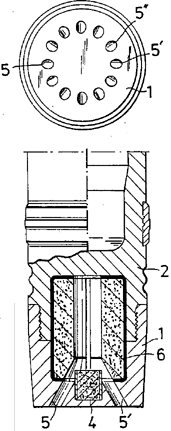Base bleed

Base bleed is a system used on some artillery shells to increase their range, typically by about 30%.
Most of the drag on an artillery shell comes from the nose of the shell, as it pushes the air out of its way at supersonic speeds. Shaping the shell properly can reduce this greatly. However, another powerful source of drag is the low-pressure area left behind the shell due to its blunt base. This drag is difficult to remove, because the shell must be "nose heavy" in order to have proper ballistics, and cannot easily be shaped into a more aerodynamic form.
Base bleed can reduce this drag without extending the base of the shell. Instead, a small ring of metal extends just past the base, and the area in the rear of the shell is filled with a small gas generator. The gas generator provides little to no thrust, but simply increases the pressure in the area behind the shell with an inflow of gas, dramatically reducing the drag. The only disadvantages are a small loss of accuracy due to the somewhat more turbulent airflow, and a small loss in explosive payload due to some of the space inside the shell being taken up by this mechanism.
Since base bleed extends the range by a percentage, it is only really useful on longer range artillery where some 5 km to 15 km increase can be achieved. Until the late 1980s the small gains in range was not considered worthwhile for field artillery. Base bleed shells are becoming more common in units equipped with modern artillery which have far greater range than the old ones.
History
The principles were developed in Sweden in the late 1960s, by the Swedish National Defence Research Institute and the Artillery bureau at the Kungliga Materielförvaltningen (later the Defence Materiel Administration). Their goal was to increase the range of coastal artillery. By 1966, it had been concluded that a small, slow-burning charge at the base of the projectile would alleviate the low pressure behind the shell, hence increasing the range by lessening the difference between the pressure due to aerodynamic drag on the nose of the shell and the low pressure behind the base. The first full-scale tests took place in 1969 with modified 10.5 cm steel shells with excellent results, and the Swedish patent was filed in 1971.
The concept was quickly implemented into the 7,5 cm sjömålsgranat m/66 (7,5 cm anti-shipping shell m/66) used in the 7,5 cm tornpjäs m/57 fixed coastal artillery gun, and then rapidly into all anti-shipping shells in the Swedish military.
Since the gas generator for the 12 cm sjömålsgranat m/70 (12 cm anti-shipping shell m/70), used in the 12 cm TAP m/70 fixed coastal artillery gun, was to be manufactured by a company in the USA, the classification secret was removed from the patent. Shortly thereafter, the international rights were sold out ending up with the Space Research Corporation (SRC), owned by Gerald Bull.
See also
References
- Grenander, Gunnar: Vapenlära för armén, Liber, Stockholm 1987. ISBN 91-38-09025-2.
- Hansson, Lars: ERSTA - Från svarvspån till byggnadsminne, LAH Bunkertours, 2008. ISBN 978-91-977297-0-3.